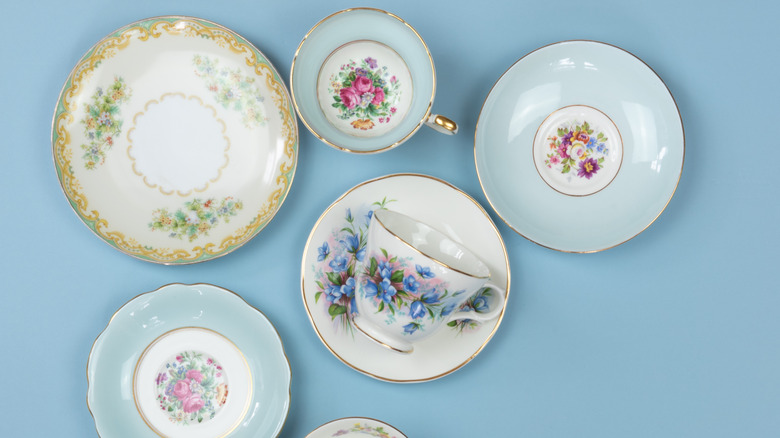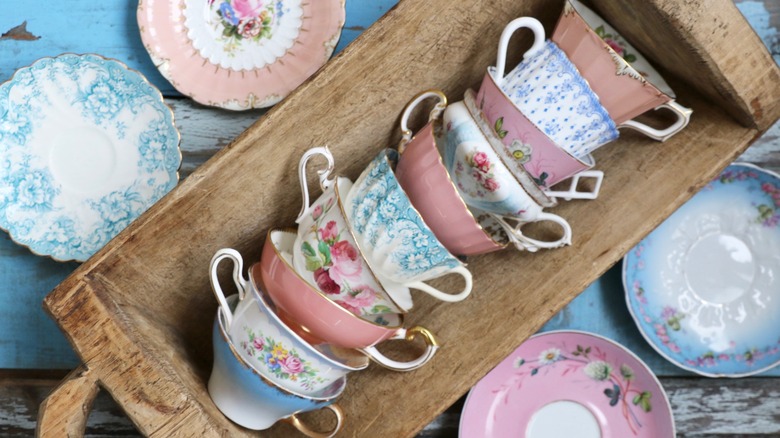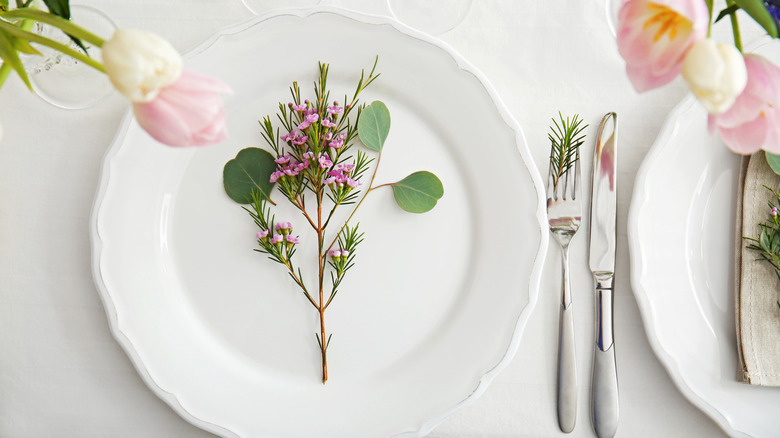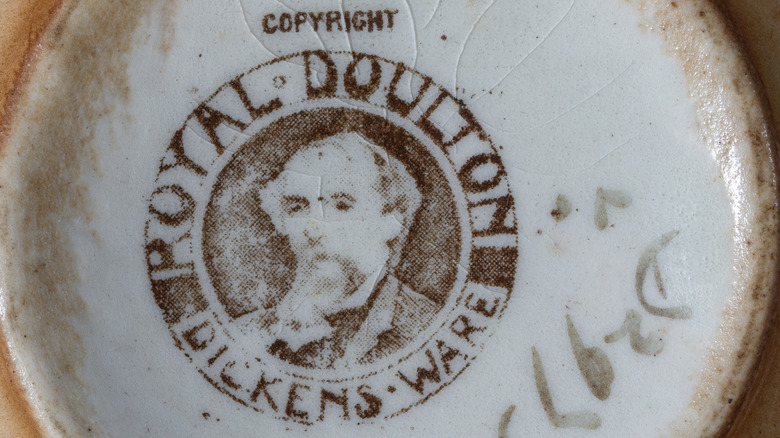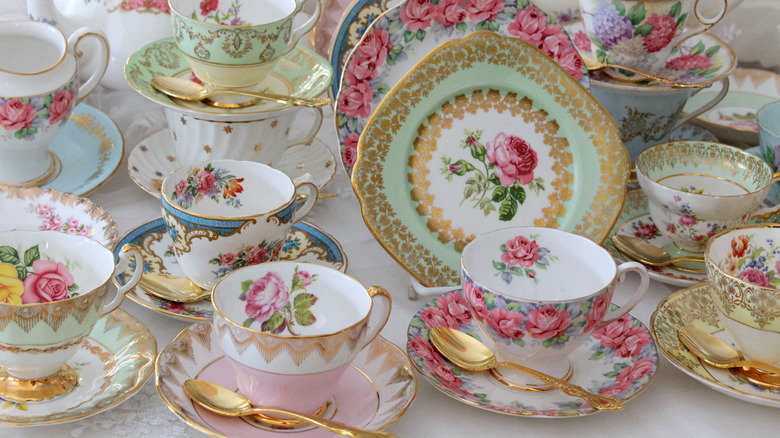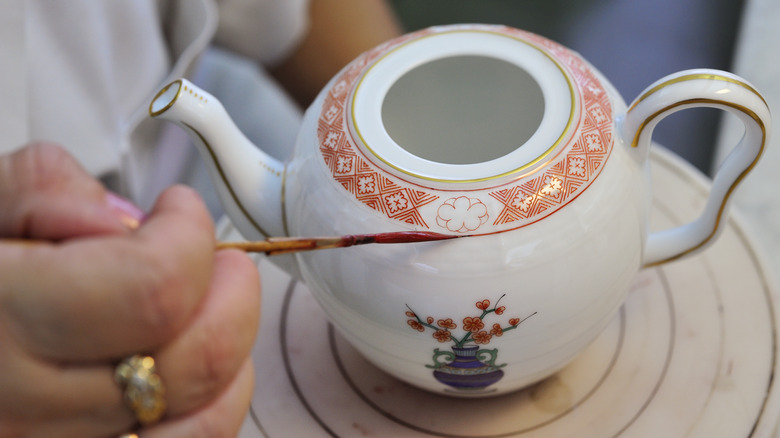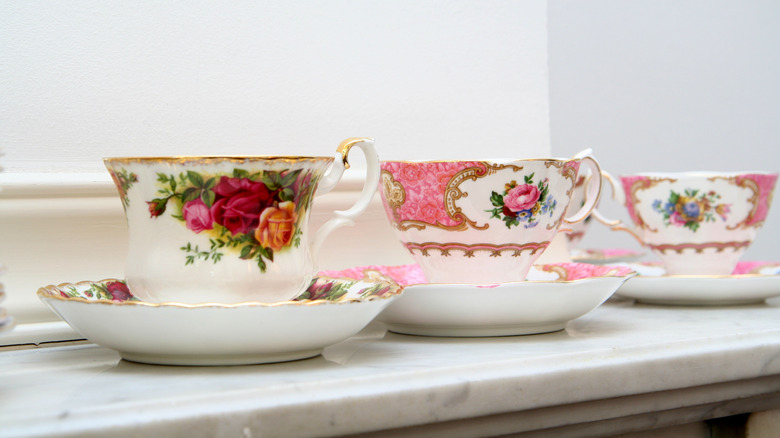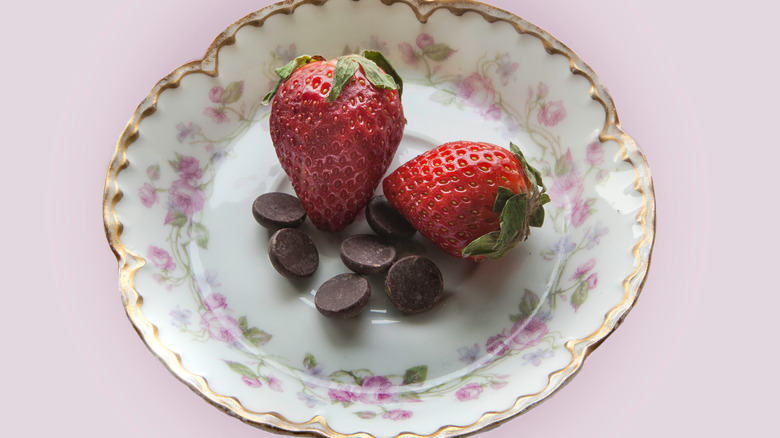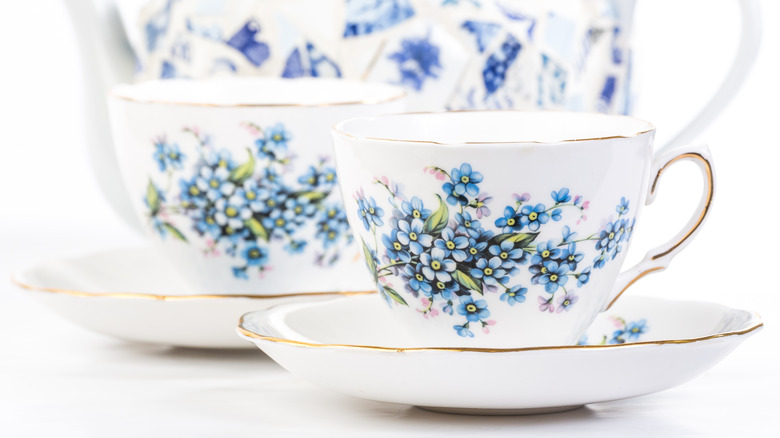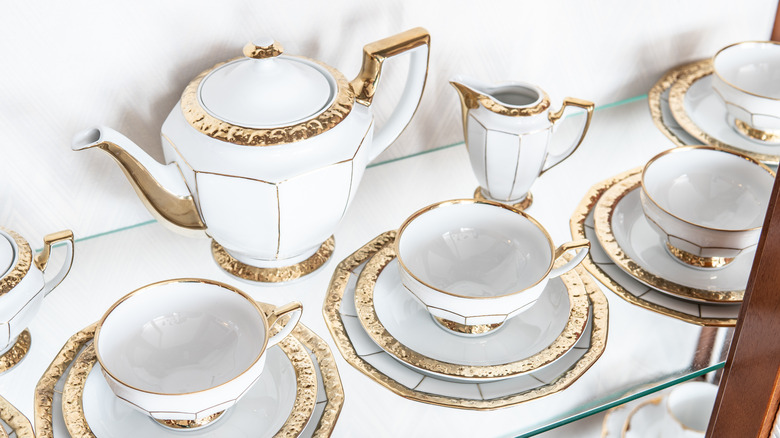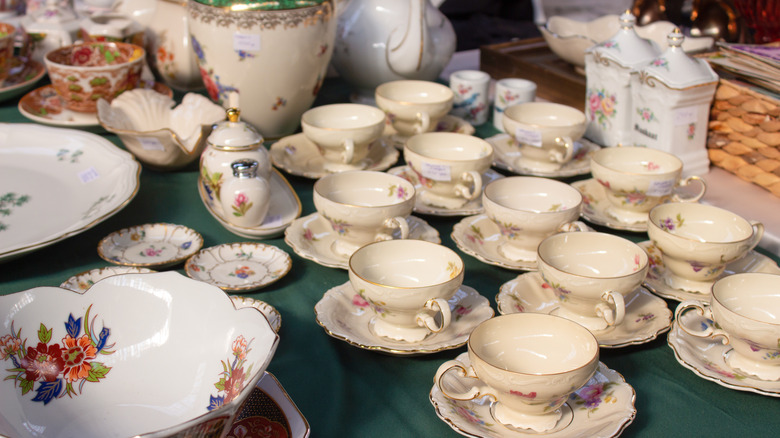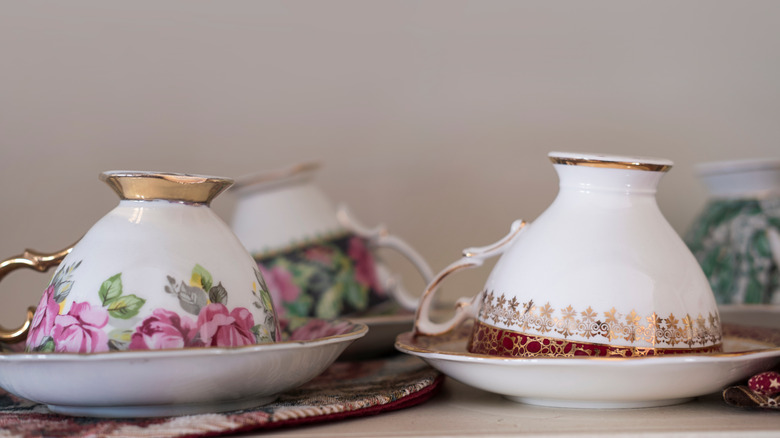Everything You Need To Know About China Patterns
Think using formal china is old-fashioned? Think again. Whether the china is old or new, it's forever stylish. The Lux Authority says fine china describes a specific dinnerware or decorative item. The decorative glazes and finishing touches distinguish fine and ordinary china. Collectors Weekly reports that the Chinese started producing decorated porcelain over 1,000 years ago. European potteries began around the 18th century, and mass production started in the late 19th century.
According to The Desert Sun, the fine china that originated in the Tang dynasty, which ran from 618 to 907 A.D., was very delicate. But over hundreds of years, additives helped make it stronger. The market has been steady over the years, but it fell out of fashion in the 1950s when dishwasher-safe plates, bowls, and cups became mainstream. Soon the perception was that porcelain was too frivolous, delicate, and burdensome to wash.
However, things began to change in recent times. Due to everyone being cooped up indoors, the pandemic inspired the idea of actually using the good china hidden behind cupboards instead of saving it for a special occasion. "Plates that I had been saving, I now use them every day," New Yorker Laura Chautin told The New York Times. "It just feels special — why not use things that make you happy on a day-to-day basis?"
Liz Curtis, chief executive and founder of Table + Teaspoon, a nationwide tableware rental service, says it's trendy to mix and match vintage china for a modern twist on the classic look. She told The Washington Post, "The table setting sets the tone for the evening. If your guests walk in and it looks like you spent time curating the table, it makes them think they are having an elevated experience." Looking to curate your own set? Here is everything you need to know about china patterns.
The three types of fine china
As ShopLegacies explains, there are three types of china. The first is bone china, which is delicate and originates in Britain. It's made from bone ash, stone, and clay. It typically has an ivory shade and is translucent. Next is hard-paste porcelain, which originated in China and features kaolin and ground alabaster. Lastly, soft-paste porcelain comes from a softer clay and was primarily made by Europeans. Both hard-paste and soft-paste porcelain are white in color.
According to Everten, the highest quality bone china typically has 30% or more cow bone ash. That's the industry standard set by Noritake. Fine china is heavier than bone china, and fine bone china is thinner and smoother than fine china. Sound is another way to determine what type of china you have. Toast two teacups together and listen. Fine china has a thick ding sound without an echo, while bone china makes a trilling, bell-ringing sound with an echo.
What's included in standard sets
Grundig says most formal dinnerware sets include five pieces: a teacup and saucer, a dinner plate, a bread plate, and a salad or dessert plate. Experts advise having enough individual place settings for eight to 12 guests, depending on the size of your formal get-togethers. For example, this Lenox butterfly meadow porcelain china sold on Wayfair is available in a set of 28 pieces, including four dinner plates, four salad plates, four mugs, four bread and butter plates, four dessert bowls, four rice bowls, and four regular bowls. You can also buy coordinating pieces like this Lenox Butterfly Meadow seven-piece pasta/salad set, also sold on Wayfair.
According to Classic Replacements, sizes can often vary per brand and style, such as a 7.5-inch plate or an 8.5-inch plate, which can both be considered salad plates. There are also many additional pieces for the formal table, including luncheon plates, soup bowls, cereal bowls, charger plates, mugs, and more. There are also serving pieces, including a sugar bowl, serving platter, creamer, gravy boat, soup tureen, and others.
Always read the bottom of your piece
Trying to figure out what kind of fine china you have? Start by looking at the bottom of your teacup or the back of your plate. That's where you should see a stamp, known as a backstamp, which identifies the fine china's origins, as per Shop Legacies. The backstamp can help you determine when and where the items were produced. Sometimes there may be two marks, one indicating the manufacturer and the other indicating the painter.
Backstamps may fade over time, and early bone china may not have one at all. If you have trouble reading the stamp, try using a magnifying glass to see the stamp better or taking a photo on your phone so you can enlarge it. Look at the details on the piece of china — such as featured colors, gold trim, or designs/motifs – to give you even more clues about its origin. If you can't locate a backstamp on your piece, you can contact a professional appraiser.
Read up about the brands online
Now that you know where to find a backstamp on your fine china, do some research to see what you have. Kovels breaks down the vocabulary of marks, including names and terms you may see stamped on a piece of china. Some examples include "fabrique par," which is French for "manufactured for," or "hochfein," which is German for "super fine." Kovels also has a dictionary of marks, such as common British pottery and porcelain stamps and German porcelain marks with animals.
Another popular reference site, Gotheborg, is a detailed go-to guide about antique Chinese and Japanese porcelain. Figurines-Sculpture.com has a detailed A to Z guide of bone china brands, including a page on brands such as Aynsley china from England; Lenox Tableware from the U.S.; Rockingham, which was a pioneer of English china and only was in business from 1745 to 1842; Royal Albert from England, known for its "Old Country Roses" pattern; and many others.
Popular colors, styles, and images in fine china
While the base color of china is white or ivory, the designs can be quite colorful. As That's Mandarin explains, color is important in Chinese culture. Red is a lucky color that brings happiness and is thought to ward off evil; yellow represents warmth; and green is for purity, health, and happiness.
According to The Pottery Wheel, popular Chinese designs included lucky Chinese and Buddhist symbols, as well as images like dragons, flowers, scrolls, waves, and others. In comparison, European designs, which were created to entice Western shoppers, featured images like Dutch windmills or Roman landscapes. One popular style was birds. For example, European china maker Herend is known for its Herend Rothschild decor, which features birds, butterflies, bugs, and nature. The design was named after the wealthy Rothschild family, who loved the bird design and were patrons of the Herend Porcelain Manufacture, based in Austria. There are 12 bird couples in the china pattern, all symbolizing love.
Your china's style may have clues about its origins. For example, according to Antique Mall, unmarked, cream-colored plates with blue florals were popular in the 1800s; unmarked bone china in pastels featuring floral designs, such as violets, was likely produced 100+ years ago, during the period 1900 to 1920; and china in bright hues including green, blue, and red, were likely produced between 1940 and 1950 when pastels weren't as popular.
Popular patterns you need to know about
Given the history of fine china and bone china around the world, many patterns have been produced over the years. ShopLegacies says many designs are timeless, including Flora Danica by Royal Copenhagen, Blue Italian by Spode, Ming Dragon by Meissen, and Raffaellesco by Deruta. Replacements, Ltd. has a photo directory of 96 of the most popular patterns. Some of its top 10 designs include Blue Danube by Blue Danube, Holiday (Dimension) by Lenox, Carlisle by Royal Doulton, and Old Country Roses by Royal Albert.
Wedding blog Over the Moon raves about the following five china patterns: the blue Chinese bouquet place setting by Herend, which features 24-carat gold accents; Palace Collection by Bernardaud, which has a modern and minimalistic style; the English Lace 60-piece place setting by Wedgwood, which is both formal and simple; Palette dinnerware by Anna Weatherley, which the site praises for its elegance, scalloped edges, and color options; and the Blue Fluted Half Lace design by Royal Copenhagen, which exudes luxury and romance.
How to find the pattern
Finding the pattern can be easy if you have a popular style, but it can also be challenging if your item isn't well-marked and you can't find identifiers. If you know the brand of the china, you can search online directories for similar pieces. For example, Haviland china can be researched on Haviland Online, where you'll find photos of 30,000 to 60,000 patterns made by the company, including Haviland and Co, Theodore Haviland Limoge, Johann Haviland, and Charles Field Haviland china. You can also check out Noritake patterns online at Robbins Nest Noritake Directory, and explore the top 80 luxury porcelain brands and manufacturers on The International Man.
Research popular brands on Replacements, Ltd. It also has an identification tool on its website so its experts can help identify your china. Upload front and back images of your china and include any details about the product, including markings, colors, or trim. They'll get back to you in three to five days.
How to determine quality of your fine china
Just because it's called fine china doesn't mean it's necessarily going to be in great condition. So how can you tell if it's quality? Tangshan Longway Ceramics advises holding up your plates and bowls to the light. They should be thin, milk-white in color, and symmetrical. Does the item sit in a stable manner, or is it lopsided or shaky? Examine the piece to ensure it has no cracks, chips, or breaks. Gently touch the product to see if the glaze is smooth or if there are any imperfections. If the design features gold or silver, rub it with your fingers to see if the metallic sheen stays on or buffs off.
Make sure each piece in the set has the same matching quality, without variations in color, pattern, sheen, etc. Ensure the logo is centered on the bottom of the item and that it's clean without any stains.
Buying vintage fine china
If you want to pick up a few pieces of china or a whole set, you may be in luck. As CBC News reports, older generations are downsizing, and most millennials don't want their parents' china. "There's still a demand for it, but it's not to the same level it once was, where every young girl at the age of 13 chose her china pattern and got a piece for every special occasion until she got married, and by then she had a complete set of dinnerware," appraiser Jannie Stoodley told CBC. "But unfortunately, the world has become more casual."
She estimates that Royal Crown Derby, which used to sell for over $500 a set, is now a deal for about $75 per set. The Pottery Wheel says china isn't as valuable as it once was, especially for brands like Wedgwood China, Royal Copenhagen, Lenox, and others. Many times the pieces are sold at estate sales.
The Teacup Attic sells vintage china online and offers these tips for choosing an online seller: Look for reputable sellers who are experts in fine china and who have websites, good reviews, and are willing to offer a money-back guarantee. It warns against buying from sellers with low prices but high shipping fees. That usually indicates the seller is trying to avoid paying fees charged from the selling platforms, like Etsy or eBay.
Selling your fine china
Do you have china you don't want that's just collecting dust in your attic or basement? There's a resale market for your fine vintage china, but don't expect to get full value. Josh Phelps, the primary china buyer for a tableware company, told Sell Adviser that sellers have two options: Selling the china themselves online through websites like Craigslist or eBay and brokering sales at the local level, such as at garage or estate sales; or they can choose to sell their china to replacement companies.
Consider this when selling your china: How long your pattern was manufactured, how pricey it is, how mainstream the style is, when the practice was discontinued, and how many pieces you have. Check the item for wear and tear, including how much it was used and if there's any damage, such as cracks or chips. He advises knowing exactly what you have so you can get the best deal. If you choose to sell to a replacement china company, get a few price quotes because each dealer may have a different need and demand and, therefore, may be willing to pay you a higher rate.
Make sure you take quality photos of the items you want to sell, including the front design and the backstamp. Determine your china's value on Replacements, Ltd. and then prepare yourself not to get the total retail value. You'll likely only get a quarter to half of that price when you actually sell the items.
Caring for fine china
Caring for fine china is a deliberate, careful process. The Lux Authority recommends washing dishes soon after eating and not allowing them to sit unwashed overnight. It advises putting a thick towel at the bottom of the sink to protect the set from chipping, filling it with warm water and mild soap, and being cautious not to rattle the dishes. Wash one piece at a time using a soft sponge or microfiber towel.
If the dishes are stained, create a solution of 1:1 salt and vinegar, and soak them before washing them. Gently rub away the stains with a soft sponge and rinse. Dry each item with a soft clean towel and put paper towels or napkins between dishes to prevent damage. They caution against stacking the police on top of each other, which could result in damage.
Paul Smith, an independent design company in Britain, says bone china and fine china can be dishwasher safe on a gentle cycle. Still, it cautions that the maximum hot water temperature shouldn't exceed 150°F. It advises against using steel wool or other abrasive cleaning tools. It also advises heat safety with bone china and fine china, including never pouring boiling hot liquids in or around a cold china item. Instead, warm the china and let the hot liquid cool a bit post-boil so as not to crack the piece.
How to fix broken china
Ideally, your china is in good condition, but accidents happen, and you might have a favorite item, such as a saucer or cup handle, that needs repair. According to Artistry in Glass, you don't have to be a professional to fix a broken plate that's in two or three pieces. First, you must ensure the fractured pieces still fit together and that they're clean without dirt, residue, or old glue. Next, set up your workstation so the bottom part can be propped upright in a box filled with sand, salt, kitty litter, rice, or any other supportive loose material. The top piece will be ready to be glued to the bottom piece.
Apply a thin coat of glue to one of the broken edges before putting the pieces together and wiping off the extra glue. Make sure the china is balanced with proper support while it dries because the drying process requires at least three to four minutes, and the smallest movement can damage the repair. Ideally, it will sit untouched for at least 12 hours.
If a piece has multiple breaks and it's too tough to repair as an amateur, you can take it to a professional for repair. But once a plate cup or any other piece of china has been glued and restored, it cannot be used again for serving food. Instead, it's best used for decorative display.
